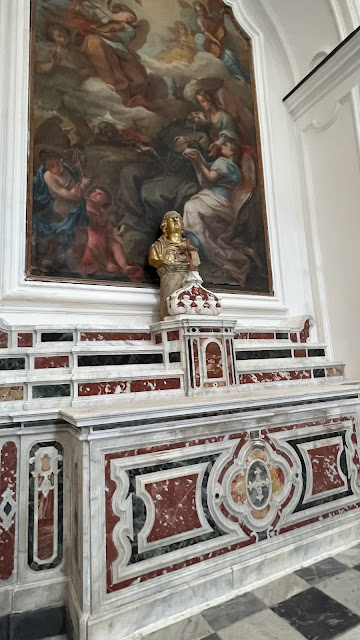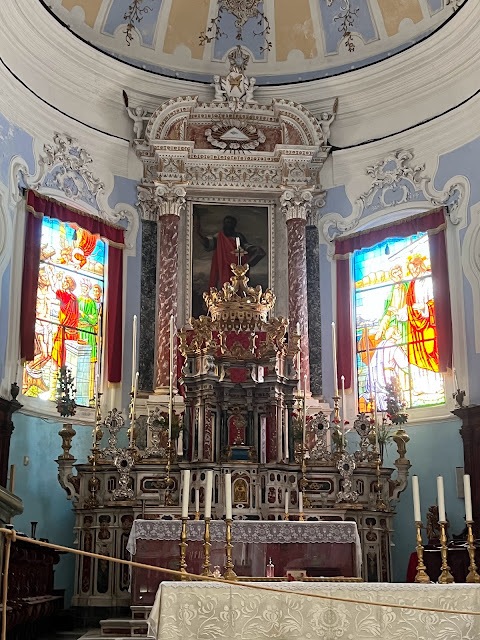We walked up to the Castle of Lipari. It is quite a complex - castle, citadel, a number of large churches (in fact five which were once private family churches), and today there are museums and an archaeological park with stonework dating back to the Bronze Age.
 |
| Part of the archeological park |
Lipari has a tortured history being in turn invaded, decimated or occupied by Greeks, Romans, Byzantines, Arabs, Cathaginians, Normans, Aragonese, Spaniards, and the Etruscans - in no particular order. They say that the site of the Castle of Lipari has been occupied since Neolithic times (4.000 BC) and was the origin of the ancient village of Lipari.
 |
| Caper bushes spilled down the castle walls waving their pretty feathery flowers. |
 |
| The ramparts were quite imposing |
 |
| Inside the walls there were more steps! |
 |
| Lindsay peering down at the port - a long way down. A very strategic position. |
 |
| A leafy terrace to rest our feet |
After climbing many steps it was wondeful to take a break in a shady terrace near the top of the citadel. The trees were eucalyptus trees! It seems that Napoleon's Josephine is responsible for Australia’s eucalypts being brought to the Mediterranean. They have 'naturalised' to many countries around the world.
 |
| Behind the facade and bell tower of the Duomo |
 |
| Massive doors with bronze panels |
 |
| Opulence in excess |
 |
| Marble in many hues |
 |
| I did say opulence! |
 |
| A ship made of silver |
Next we visited the cathedral - such opulence. A beautiful silver scalputre of a ship now behind glass represents the ship loaked with grain and other food which saved Lipari from starvation. It used to be taken out for processions but is kept behind locked glass these days.
Around C11th the Normans arrived to find only a small number of Greek-speaking people living on the island. The Normans built the monastery and cloisters alongside the cathedral to St Bartholemew within the castle walls around 1130. In 1544 a Turkish fleet, after eleven days of siege, destroyed Lipari and deported 8,000 inhabitants as slaves. Of course the rebuild was bigger and better. And then came an earthquake! What a devastating history. White Austrsalians simply have no concept of such horror but ...
 |
| The cloisters |
 |
| Tranquility |
 |
| More caper bushes. They look so right here |
 |
| These ancient coloured stone blocks blazed out from the shadows. |
A large part of the cloisters was damaged by the earthquake and lay abandoned only to be rediscovered 40-odd years ago. It is quite beautiful and tranquil and reminded me of Iona in Scotland (it predates this by about 500 years). The existing columns come from earlier Roman houses as well as some of the remaining ancient floor fragments.
 |
| Back outside the views were stunning but we had to walk back down! |
By the time we got back to the port we were pretty hot so we looked for and found a cool breezy spot by the harbour for a cool drink and there we sat watching the sea swishing in and out in front of us.

























No comments:
Post a Comment